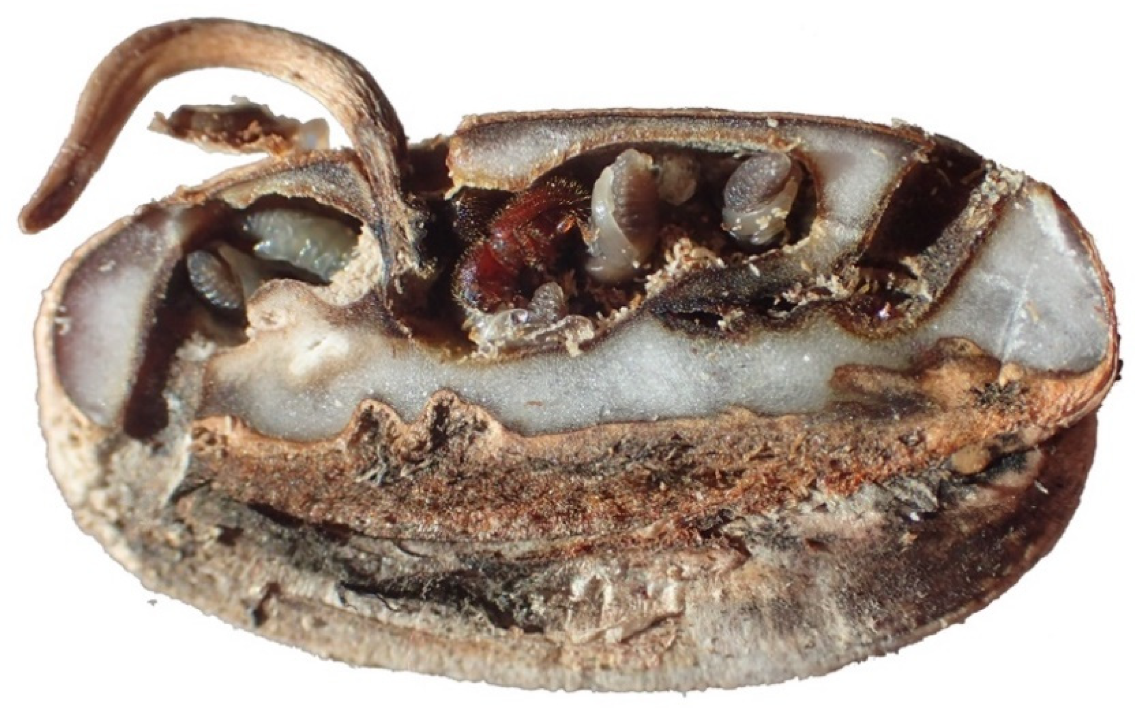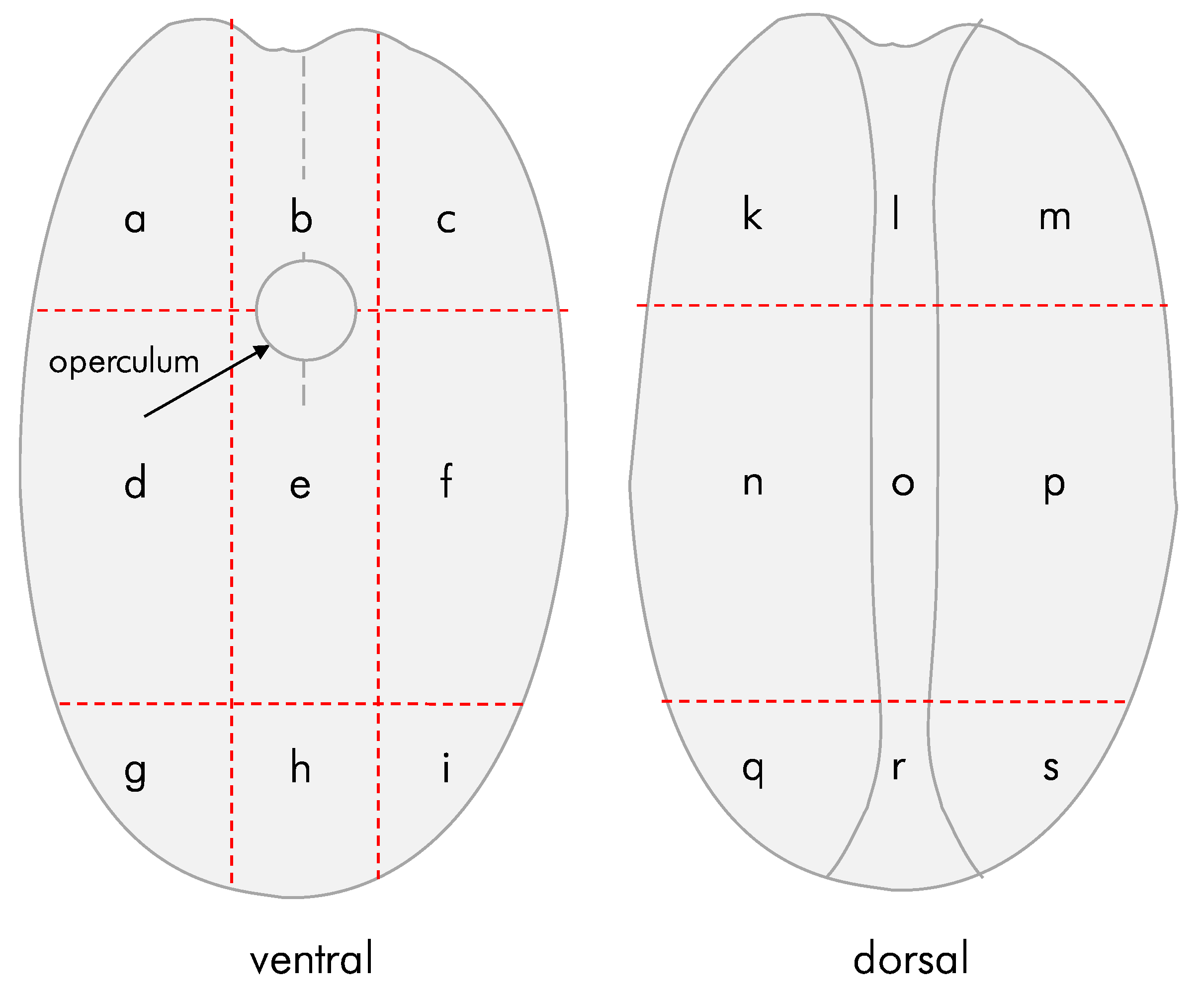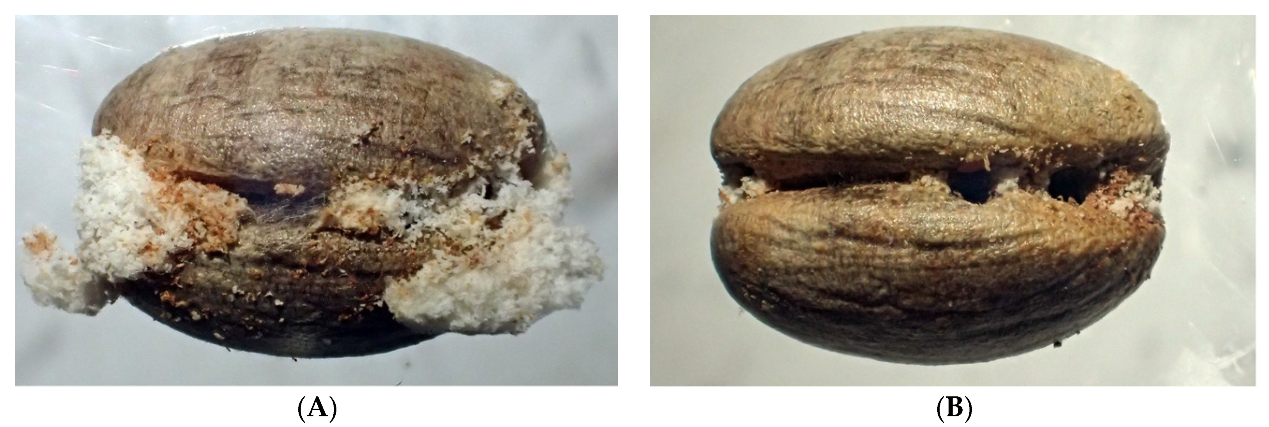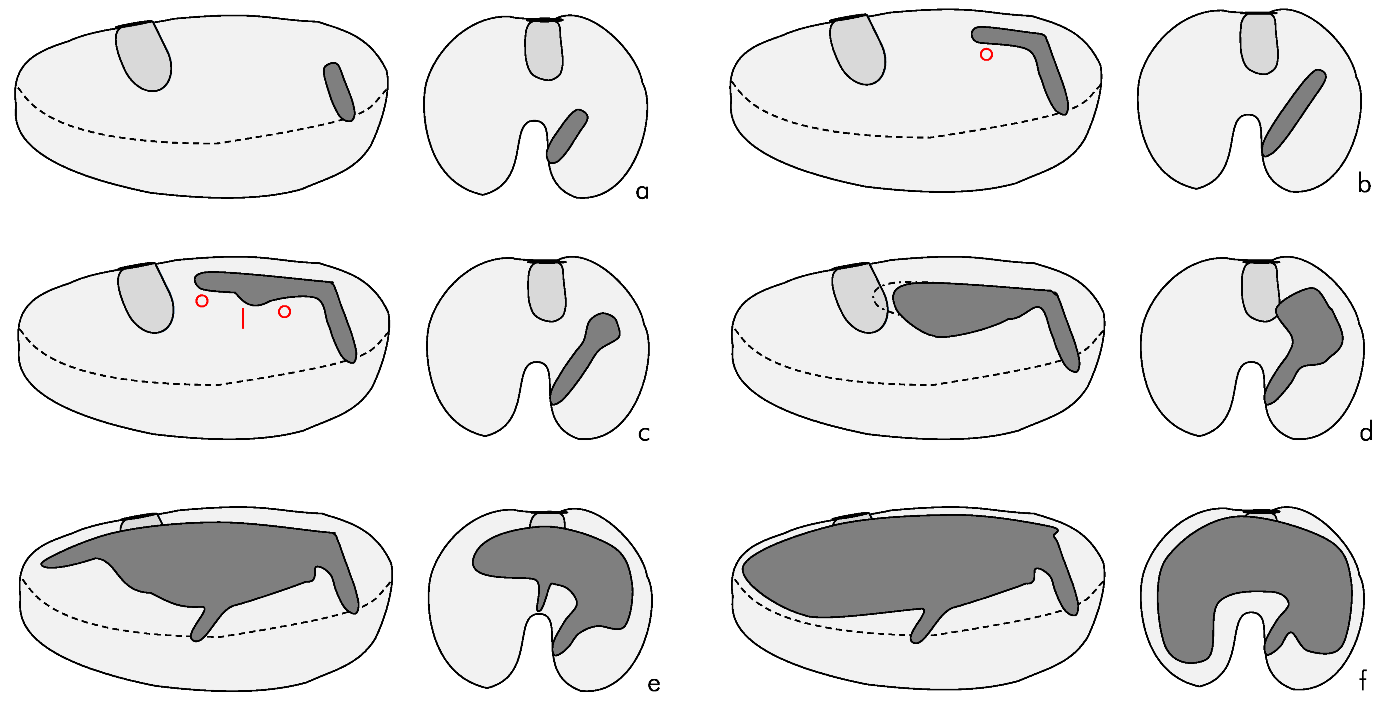Patterns of Seed Penetration by the Date Stone Beetle Coccotrypes dactyliperda (Coleoptera, Curculionidae, Scolytinae)
Abstract
:Simple Summary
Abstract
1. Introduction
2. Methods
2.1. Designs
2.1.1. Mass Exposure Experiments
2.1.2. Retrospective Examination
2.1.3. Exposure to Seeds with Open Operculum
2.1.4. Nature of Penetration
2.2. Recording
2.2.1. Location of Penetration
2.2.2. Nature of Penetration
2.3. Statitics
3. Results
3.1. Location of Penetration
3.2. Nature of Penetration
4. Discussion
4.1. Tunneling and Gallery Building Process
4.2. Patterns of Turning
4.3. Exit Holes
5. Conclusions
Supplementary Materials
Funding
Institutional Review Board Statement
Conflicts of Interest
References
- Schedl, K.E. Scolytidae und Platypodidae Afrikas. Rev. De Entomol. De Mocamb. 1961, 4, 355–742. [Google Scholar]
- Fabricius, J.C. Systema Eleutheratorum Secundum Ordines, Genera, Species: Adiectis Synonymis, Locis, Observationibus, Descriptionibus; Impensis Bibliopolii Academici Novi: Kiel, Germany, 1801; Volume 2, p. 314. [Google Scholar]
- Letzner, C.W. Ueber den Bistrochus dactyliperda und seine frühern Stände. Uebersicht der Arbeiten und Veränderungen der Schlesischen Gesellschaft für Vaterländische Cultur in Jahre 1839 1840, 17, 116–120. [Google Scholar]
- Eichhoff, W. Ratio, descriptio, emendatio eorum Tomicinorum qui sunt in Dr. Chapuisi et autoris ipsius collection et autoris ipsius collectionibus et quos praeterea recognovit. Mémoires De La Société R. Des Sci. De Liege 1879, 8, 1–554. [Google Scholar]
- Blumberg, D.; Kehat, M. Biological studies of the date stone beetle, Coccotrypes dactyliperda. Phytoparasitica 1982, 10, 73–78. [Google Scholar] [CrossRef]
- Herfs, A. Studien an dem Steinnußborkenkäfer Coccotrypes tanganus Eggers. Höfchen-Briefe Für Wiss. Und Prax. (Bayer Leverk.) 1948, 2, 22–49. [Google Scholar]
- Herfs, A. Studien an dem Steinnußborkenkäfer Coccotrypes tanganus Eggers. Die Soziologie von Coccotrypes tanganus. Höfchen-Briefe Für Wiss. Und Prax. (Bayer Leverk.) 1950, 3, 3–31. [Google Scholar]
- Holzman, J.P.; Bohonak, A.J.; Kirkendall, L.R.; Gottlieb, D.; Harari, A.R.; Kelley, S.T. Inbreeding variability and population structure in the invasive haplodiploid palm-seed borer (Coccotrypes dactyliperda). J. Evol. Biol. 2009, 22, 1076–1087. [Google Scholar] [CrossRef]
- Sitkov-Sharon, G.; Tremmel, M.; Bouskila, A.; Lubin, Y.; Harari, A. Inbreeding, but not seed availability, affects dispersal and reproductive success in a seed-inhabiting social beetle. Behav. Ecol. Sociobiol. 2017, 71, 178. [Google Scholar] [CrossRef]
- Zchori-Fein, E.; Borad, C.; Harari, A.R. Oogenesis in the date stone beetle, Coccotrypes dactyliperda, depends on symbiotic bacteria. Physiol. Entomol. 2006, 31, 164–169. [Google Scholar] [CrossRef]
- Boraei, H.A. Effect of temperature and photoperiod on the dormancy of the date stone beetle, Coccotrypes dactyliperda. J. Agric. Res. Tanta Univ. 1994, 20, 72–79. [Google Scholar]
- Donia, A.R.; El-Barbary, N.S.; Mostafa, A.M. The seasonal abundance of the date stone beetle, Coccotrypes dactyliperda Fabricius (Coleoptera, Scolyticdae). Alex. J. Agric. Res. 2002, 47, 93–102. [Google Scholar]
- Blumberg, D. Review: Date Palm Arthropod Pests and Their Management in Israel. Phytoparasitica 2008, 36, 411–448. [Google Scholar] [CrossRef]
- Abd-Allah, F.F.; Tadros, A.W. Biological studies on the date stone beetle, Coccotrypes dactyliperda Fabricius (Coleoptera: Scolytidae). Alex. Sci. Exch. 1994, 15, 1–9. [Google Scholar]
- Hussein, A.E. Date varieties and palm height in relation to infestation with date stone beetle, Coccotrypes dactyliperda F. (Coleoptera: Scolytidae). Ann. Agric. Sci. Moshtohor 1990, 28, 2613–2622. [Google Scholar]
- Kehat, M.; Blumberg, D.; Greenberg, S. Fruit drop and damage in dates: The role of Coccotrypes dactyliperda F. & nitidulid beetles, and prevention by mechanical measures. Phytoparasitica 1976, 4, 93–99. [Google Scholar]
- El-Sufty, R.; Helal, R.M. Studies on the date stone beetle, Coccotrypes dactyliperda F. (Col:Scolytidae) in North of Nile Delta. Menofiya J. Agric. Res. 1998, 23, 1683–1692. [Google Scholar]
- Boraei, H.A.; Khodeir, I.A.; El-Hawary, I.S. On the biology, damage and food preference of the date-stone palm beetle, Coccotrypes dactyliperda F.(col., Scolytidae), a newly serious pest of palm trees at the northern regions of the Nile Delta. J. Agric. Res. Tanta Univ. 1994, 20, 80–90. [Google Scholar]
- El-Barbary, N.S.; Donia, A.R.; Mostafa, A.M. Effect of food preference and extracts of the date palm fruits and stones on the activity of the adult females of the date stone beetle, Coccotrypes dactyliperda Fabricus (Coleoptera, Scolytidae). Alex. J. Agric. Res. 2002, 47, 103–107. [Google Scholar]
- Bathon, H. Coccotrypes dactyliperda (Fabricius ) (Col., Scolytidae) nach Deutschland importiert. Dtsch. Ges. Für Allg. Und Angew. Entomol. 2007, 21, 63. [Google Scholar]
- Anonymous. The button beetle (Coccotrypes dactyliperda). Agric. Gaz. New South Wales 1939, 50, 319–320. [Google Scholar]
- Van der Merwe, C.P. The Destruction of Vegetable Ivory Buttons. The Ravages of the “Button Beetle” (Coccotrypes dactyliperda, F.) and Suggestions for Its Control; Department of Agriculture, Union of South Africa: Pretoria, South Africa, 1923. [Google Scholar]
- Spennemann, D.H.R. Global distribution of the date stone beetle, Coccotrypes dactyliperda (Coleoptera: Curculionidae, Scolytinae). J. Insect Biodiv. Syst. 2018, 4, 203–226. [Google Scholar]
- Spennemann, D.H.R.; Pike, M.; Robinson, W. Germination rates of old and fresh seeds and their implications on invasiveness of the ornamental Canary Islands date palm (Phoenix canariensis). Eur. J. Ecol. 2021, 6, 70–86. [Google Scholar] [CrossRef]
- Spennemann, D.H.R. Resilience of breeding Coccotrypes dactyliperda (Coleoptera, Curculionidae, Scolytinae) to ingestion by vertebrates. Turk. J. Entomol. 2020, 44, 205–217. [Google Scholar] [CrossRef] [Green Version]
- Spennemann, D.H.R. An Experimental Evaluation of Food Preferences and Associated Hatching Times of the Date Stone Beetle, Coccotrypes dactyliperda (Scolytinae, Coleoptera); Institute for Land, Water and Society, Charles Sturt University: Albury, Australia, 2018; p. 81. [Google Scholar]
- Spennemann, D.H.R. Resilience of the date stone beetle Coccotrypes dactyliperda (Coleoptera, Curculionidae), following periods of exposure to subzero temperature. Turk. J. Entomol. 2019, 43, 379–385. [Google Scholar]
- Spennemann, D.H.R. Infestation of vertebrate defecated palm seeds by Coccotrypes dactyliperda (Coleoptera, Curculionidae, Scolytinae) and its implications on the dispersal of palms. Orient. Insects 2021, 55, 1–9. [Google Scholar] [CrossRef]
- MedCalc Software. MEDCALC. Comparison of Proportions Calculator. Available online: https://www.medcalc.org/calc/comparison_of_proportions.php (accessed on 20 October 2021).
- Campbell, I. Chi-squared and Fisher-Irwin tests of two-by-two tables with small sample recommendations. Stat. Med. 2007, 26, 3661–3675. [Google Scholar] [CrossRef] [PubMed]
- Richardson, J.T.E. The analysis of 2 × 2 contingency tables—Yet again. Stat. Med. 2011, 30, 890. [Google Scholar] [CrossRef] [PubMed]
- University of California. Confidence Interval for A Proportion; Department of Epidemiology and Biostatistics, University of California: San Francisco, CA, USA, 2019. [Google Scholar]






| Sample | Seeds | Exposure | Beetles | Number of Beetles Used | Seeds with Single Penetrations |
|---|---|---|---|---|---|
| #1 | seed from fresh drupes | multiple | multiple | 210 | 134 |
| #2 | seed from fresh drupes | multiple | Multiple | 150 | 100 |
| #3 | seed, mixed | single, gridded | multiple | >90 | 90 |
| #4 | seed, dry | single, gridded | multiple | >56 | 56 |
| #5 | seed, mixed | single | single | 82 | 82 |
| #6 | germinated seed, dry | multiple | multiple | 30 | 30 |
| #7 | germinated seed, dry | multiple | multiple | 30 | 15 |
| #8 | germinated seed, black | multiple | multiple | 30 | 23 |
| Exposure Type | Distribution | Bulk | Single | Bulk | |||||||
|---|---|---|---|---|---|---|---|---|---|---|---|
| Seed State | of Probability | Fresh | Fresh | Open Operculum | |||||||
| Sample | Equal | Random | #1 | #2 | #3 | #4 | #5 | #6 | #7 | #8 | |
| Side | Sector | ||||||||||
| Ventral | a | 5.26 | 4 | 3.6 | |||||||
| b | 5.26 | 5 | 5.4 | 1.2 | |||||||
| c | 5.26 | 3 | 3.6 | ||||||||
| d | 5.26 | 4 | |||||||||
| e | 5.26 | 5 | 0.8 | 2.2 | 1.8 | 1.2 | |||||
| f | 5.26 | 7 | |||||||||
| g | 5.26 | 2 | |||||||||
| h | 5.26 | 7 | 3.6 | ||||||||
| i | 5.26 | 5 | 1.0 | 1.8 | |||||||
| Operculum | 5.26 | 6 | 33.33 | 13.33 | 30.43 | ||||||
| Dorsal | k | 5.26 | 5 | ||||||||
| l | 5.26 | 8 | 74.6 | 59.0 | 62.0 | 51.8 | 37.8 | 23.33 | 73.33 | 39.13 | |
| m | 5.26 | 6 | 1.5 | 1.8 | |||||||
| n | 5.26 | 10 | 1.1 | 1.8 | |||||||
| o | 5.26 | 3 | 9.0 | 15.0 | 10.9 | 5.4 | 26.8 | 26.67 | 6.67 | 26.09 | |
| p | 5.26 | 6 | 3.0 | 1.1 | 1.2 | ||||||
| q | 5.26 | 7 | |||||||||
| r | 5.26 | 3 | 13.4 | 22.0 | 22.8 | 19.6 | 30.5 | 16.67 | 6.67 | 4.35 | |
| s | 5.26 | 4 | 1.2 | ||||||||
| n | 100 | 100 | 134 | 100 | 90 | 56 | 82 | 30 | 15 | 23 | |
| χ2 | 110.649 | 65.767 | 69.435 | 44.954 | 29.643 | 49.193 | |||||
| df | 1 | 1 | 1 | 1 | 1 | 1 | |||||
| p | n.s. | n.s. | <0.01 | <0.01 | <0.01 | <0.01 | <0.05 | n.s | <0.01 | n.s. | |
| Bulk | Single | Bulk | ||||||
|---|---|---|---|---|---|---|---|---|
| Fresh | Fresh | Open Operculum | ||||||
| Side | #1 | #2 | #3 | #4 | #5 | #6 | #7 | #8 |
| Groove | 96.6 | 96.0 | 95.7 | 76.8 | 95.1 | 66.7 | 86.7 | 69.6 |
| Smooth Surface | 3.0 | 4.0 | 4.4 | 23.2 | 4.9 | - | - | - |
| Operculum | 0.4 | - | - | - | - | 33.3 | 13.3 | 30.4 |
| n | 263 | 100 | 90 | 56 | 82 | 30 | 15 | 23 |
| χ2 | 295.237 | 163.735 | 154.244 | 85.296 | 145.579 | 55.062 | 64.013 | 53.540 |
| df | 1 | 1 | 1 | 1 | 1 | 1 | 1 | 1 |
| p | <0.001 | <0.001 | <0.001 | <0.001 | <0.001 | <0.001 | <0.001 | <0.001 |
| Penetrations | Combination | Fresh Drupes Exp. #1 | GERMINATED Exp. #6–#8 |
|---|---|---|---|
| 5 | l (× 3), o (×2) | 1 | |
| 4 | k, l, o, r | 1 | |
| l (× 2), o (× 2) | 1 | ||
| l, o (× 2), r | 1 | ||
| 3 | l (× 3) | 3 | |
| l (× 2), r | 4 | ||
| l (× 2), o | 3 | ||
| l (× 2), p | 3 | ||
| l, r (× 2) | 2 | ||
| l, o (× 2) | 1 | ||
| l, o, r | 1 | ||
| 2 | l, r | 18 | |
| l (× 2) | 19 | 3 | |
| r (× 2) | 5 | 1 | |
| o (× 2) | 1 | ||
| o, l | 7 | 1 | |
| o, r | 2 | 2 | |
| operculum, l | 3 | ||
| operculum, o | 2 | ||
| Total Sample (n) | 263 | 68 | |
| Percent multiples | 27.4 | 19.1 | |
| Sample | Material | Hardness | Tunneling | Debris Removal | Pause | Wriggles Legs | Total |
|---|---|---|---|---|---|---|---|
| AG6 | Corylus avellana | very hard | 00:13:53 | 00:01:20 | 00:05:42 | 00:00:02 | 00:20:57 |
| AH13 | Washingtonia robusta | soft | 00:13:14 | 00:01:14 | 00:14:28 | ||
| U7 | Tagua button blank | hard | 00:03:26 | 00:03:26 | |||
| Excreta | Phoenix canariensis | soft | 01:39:38 | 00:41:40 | 02:21:18 |
| Sample | Counter-Clockwise | Clockwise | No Change | n |
|---|---|---|---|---|
| AG6 | 31.8 | 47.7 | 20.5 | 44 |
| AH13 | 78.6 | 17.9 | 3.6 | 28 |
| U7 | 16.7 | 79.2 | 4.2 | 24 |
| Excreta | 50.0 | 50.0 | 0.0 | 70 |
| Total | 45.2 | 48.2 | 6.6 | 166 |
| Sample | Counter-Clockwise | Clockwise | No Change | Total |
|---|---|---|---|---|
| AG6 | 42.3 | 31.4 | 26.3 | 00:14:58 |
| AH13 | 86.3 | 9.1 | 4.7 | 00:13:14 |
| U7 | 7.3 | 88.3 | 4.4 | 00:03:26 |
| Excreta | 54.1 | 45.9 | 0.0 | 1:33:18 |
| Total | 54.8 | 41.4 | 3.8 | 2:04:56 |
| Consecutive Turns | |||||||
|---|---|---|---|---|---|---|---|
| 1 | 2 | 3 | 4 | 5 | 6 | n | |
| clockwise | 9 | 2 | 1 | 12 | |||
| counter-clockwise | 8 | 2 | 1 | 1 | 12 | ||
| Total | 17 | 2 | 3 | 1 | 1 | 1 | 24 |
Publisher’s Note: MDPI stays neutral with regard to jurisdictional claims in published maps and institutional affiliations. |
© 2021 by the author. Licensee MDPI, Basel, Switzerland. This article is an open access article distributed under the terms and conditions of the Creative Commons Attribution (CC BY) license (https://creativecommons.org/licenses/by/4.0/).
Share and Cite
Spennemann, D.H.R. Patterns of Seed Penetration by the Date Stone Beetle Coccotrypes dactyliperda (Coleoptera, Curculionidae, Scolytinae). Insects 2022, 13, 10. https://doi.org/10.3390/insects13010010
Spennemann DHR. Patterns of Seed Penetration by the Date Stone Beetle Coccotrypes dactyliperda (Coleoptera, Curculionidae, Scolytinae). Insects. 2022; 13(1):10. https://doi.org/10.3390/insects13010010
Chicago/Turabian StyleSpennemann, Dirk H. R. 2022. "Patterns of Seed Penetration by the Date Stone Beetle Coccotrypes dactyliperda (Coleoptera, Curculionidae, Scolytinae)" Insects 13, no. 1: 10. https://doi.org/10.3390/insects13010010
APA StyleSpennemann, D. H. R. (2022). Patterns of Seed Penetration by the Date Stone Beetle Coccotrypes dactyliperda (Coleoptera, Curculionidae, Scolytinae). Insects, 13(1), 10. https://doi.org/10.3390/insects13010010






